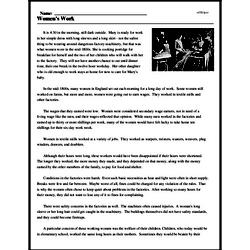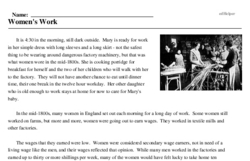Women's Work
It is 4:30 in the morning, still dark outside. Mary is ready for work in her simple dress with long sleeves and a long skirt - not the safest thing to be wearing around dangerous factory machinery, but that was what women wore in the mid-1800s. She is cooking porridge for breakfast for herself and the two of her children who will walk with her to the factory. They will not have another chance to eat until dinner time, their one break in the twelve hour workday. Her other daughter who is old enough to work stays at home for now to care for Mary's baby.
In the mid-1800s, many women in England set out each morning for a long day of work. Some women still worked on farms, but more and more, women were going out to earn wages. They worked in textile mills and other factories.
The wages that they earned were low. Women were considered secondary wage earners, not in need of a living wage like the men, and their wages reflected that opinion. While many men worked in the factories and earned up to thirty or more shillings per week, many of the women would have felt lucky to take home ten shillings for their six-day work week.




